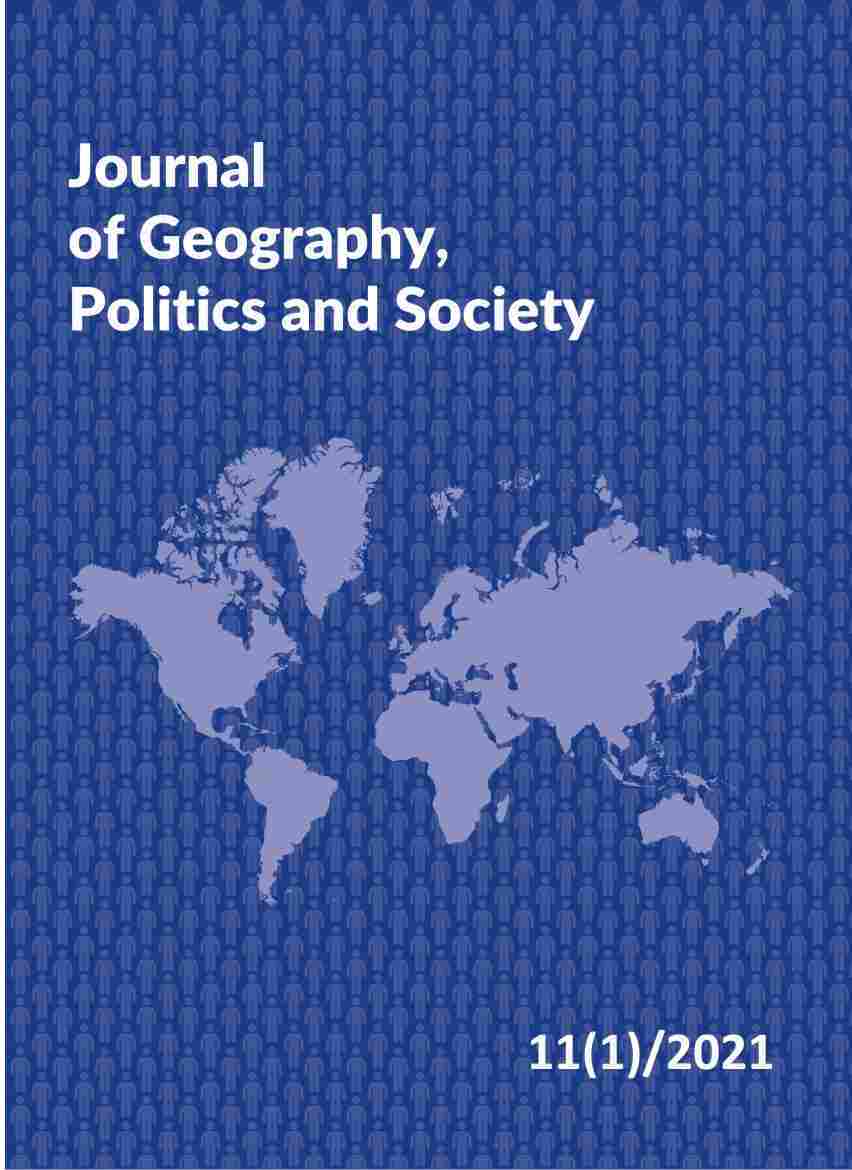Changes in the function of former seaport areas using the example of the Dalmor waterfront in Gdynia
DOI:
https://doi.org/10.26881/jpgs.2021.1.04Keywords:
Gdynia, quay, revitalisation, seaport, fishing, port cityAbstract
Currently, port cities face challenges that include activities aimed at revitalisation of post-industrial areas with special landscape, cultural, historical and representative values, as well as their urbanisation. The undertaken activities may be called a resuscitation of waterside spaces that are largely degraded. Sometimes revitalisation activities help to tighten the city’s links with water. Gdynia is an example of recreating its maritime character by returning to the water. The subject matter of this paper, concerning the transformations of the Dalmor quay, illustrates the possibilities created by disused seaport areas.
Downloads
References
Balicki A., Makać W., 1988, Gdynia w liczbach 1926–1986 (Eng. Gdynia in numbers 1926–1986), Rocznik Gdyński, 7, 81–87.
Biuletyn Informacji Publicznej Urzędu Miasta Gdyni (Eng. Public Information Bulletin of Gdynia City Hall), Urząd Miasta Gdynia, https://bip.um.gdynia.pl (accessed 25 June 2020).
Butuner B., 2006, Waterfront Revitalization as a Challenging Urban Issue, 42nd ISoCaRP Congress, http://www.isocarp.net/Data/case_studies/792.pdf (accessed 25 June 2020).
Czarniawska B., 2014, Social Science Research: From Field to Desk, SAGE Publications, Los Angeles.
Czerwińska W., 1980, Narodziny portu (Eng. Birth of the port), [in:] R. Wapiński (eds.), Dzieje Gdyni (Eng. History of Gdynia), Zakład Narodowy imienia Ossolińskich – Wydawnictwo, Wrocław, 23–41.
Drzewicki M., Romański K., 2016, Piotr Lorens: Nowoczesność to gdyńska tradycja (Eng. Modernity is tradition in Gdynia), Wyborcza.pl Trójmiasto, 14.02.2016, https://trojmiasto.wyborcza.pl/trojmiasto/1,35612,19614330,piotr-lorensnowoczesnosc-to-gdynska-tradycja.html (accessed 25 June 2020).
Giovinazzi O., Moretti M., 2010, Port Cities and Urban Waterfront: Transformations and Opportunities, TeMa – Journal of Mobility, Land Use and Environment, 3, 57–58. doi: 10.6092/1970-9870/123.
Girard L.F., Kourtit K, Nijkamp P., 2014, Waterfront Areas as Hotspots of Sustainable and Creative Development of Cities, Sustainability, 6(7), 4580–4586. doi: 10.3390/su6074580.
Hoyle B., 1997/1998, Cities and Ports: Concept and issues, VEGUETA, 3, 269–271.
Hoyle B., 2000, Global and Local Change on the Port-City Waterfront, Geographical Review, 90(3), 395–417. doi: 10.1111/j.1931-0846.2000.tb00344.x.
Januchta-Szostak A., 2012, Usługi ekosystemów wodnych w miastach (Eng. Water ecosystem services in cities), Zrównoważony Rozwój – Zastosowania, 3, 91–110.
Jones A., 1998, Issues in Waterfront Regeneration: More Sobering Thoughts-A UK Perspective, Planning Practice & Research, 13(4), 433–442. doi: 10.1080/02697459815987.
Kaliszewski A., 2017, Porty piątej oraz szóstej generacji (5GP, 6GP) – ewolucja ekonomicznej i społecznej roli portów (Eng. Fifth and sixth generation ports (5GP, 6GP) – evolution of the economic and social role of ports), Studia i Materiały Instytutu Transportu i Handlu Morskiego, 14, 93–123. doi: 10.26881/sim.2017.4.06.
Karzyński M., 2015, Rozwój Śródmieścia Gdyni – kluczowy projekt rozwoju miasta (Eng. Development of Gdynia City Centre – a key city development project), Biuletyn KPZK PAN, 259, 288–297.
Klasa M., 2007, Wodny front Dalmoru (Eng. The waterfront of Dalmor), Portal Morski, https://www.portalmorski.pl/porty-logistyka/5547-wodny-front-dalmoru (accessed 26 June 2020).
Lorens P., 2010, Plany rozwoju przestrzennego jako kontynuacja rozwoju międzywojennego (Eng. Spatial development plans as a continuation of interwar development), Renowacje i Zabytki, 4/2010, 127–131.
Lorens P., 2013, Obszary poportowe – problemy rewitalizacji (Eng. Postport areas – revitalisation problems), Instytut Studiów Regionalnych, Szczecin.
Magdziak-Grabowska M., 2012, Nowe oblicza terenów portowych (Eng. New faces for port areas), Czasopismo Techniczne. Architektura, 109, 293–297.
Mironowicz I., 2009, Przekształcenia struktur miejskich – projekty i realizacja (Eng. Transformation of urban structures – projects and implementation), [in:] P. Lorens, J. Martyniuk-Pęczek (eds.), Wybrane zagadnienia rewitalizacji miast (Eng. Selected issues of urban regeneration), Wydawnictwo Urbanista, Gdańsk, 102–138.
Misztal K., Kuźma L., Grzelakowski A., 1988, Organizacja i eksploatacja portów morskich (Eng. Organisation and operation of seaports), Wydawnictwo Uniwersytetu Gdańskiego, Gdańsk.
Misztal Z., 1980, Rozwój gospodarki Gdyni w latach 1950– 1975 (Eng. Development of Gdynia’s economy in the years 1950–1975), [in:] R. Wapiński (eds.), Dzieje Gdyni (Eng. History of Gdynia), Zakład Narodowy imienia Ossolińskich – Wydawnictwo, Wrocław, 268–290.
Palmowski T., Pacuk M., Michalski T., 2001, Przemiany przestrzeni miejskiej miast portowych na przykładach Gdańska i Gdyni (Eng. Transformations of urban space of port cities on the examples of Gdańsk and Gdynia), [in:] E. Szafrańska (ed.), XIV Konserwatorium Wiedzy o Mieście (XIV Urban Knowledge Conversatory), Wydawnictwo Uniwersytetu Łódzkiego, Łódź, 33–42.
Palmowski T., 1998, Morskie funkcje Gdyni (Eng. Gdynia’s maritime functions), [in:] E. Adrjanowska (eds.), Zespół Miejski Gdyni. Przyroda–Gospodarka–Społeczeństwo (Eng. The Gdynia City Complex. Nature–Economy–Society), Wydawnictwo Uniwersytetu Gdańskiego, Gdańsk, 111–131.
Pluciński M., 2014, Teoretyczne i praktyczne aspekty zagospodarowania przestrzeni współczesnych portów morskich ze szczególnym uwzględnieniem portów morskich o podstawowym znaczeniu dla gospodarki Polski (Eng. Theoretical and practical aspects of space development of contemporary seaports with particular emphasis on seaports of fundamental importance for the Polish economy), Logistyka – Nauka, 3, 5174–5180.
Polski Holding Nieruchomości S.A. (PHN), https://www.phnsa.pl (accessed 25 June 2020).
Romanowski C., 2012, Najpierw statki teraz ludzie (Eng. First the ships now the people), Portal Morski, https://www.portalmorski.pl/inne/21327-najpierwstatkiterazludzie (accessed 25 June 2020).
Ropelewski A., 1991, Kolebka Polskiego Rybołówstwa Dalekomorskiego (Eng. The Cradle of Polish Deep-Sea Fisheries), Rocznik Gdyński, 10, 225–237.
Śródmieście Morskie (Eng. Maritime City Centre), http://srodmiesciemorskie.pl (accessed 25 June 2020).
Turek A., 2013, Rewitalizacja obszarów poprzemysłowych na cele mieszkaniowe (Eng. Revitalisation of postindustrial areas for residential purposes), Problemy Rozwoju Miast, 10(1), 71–86.
Uchwała Nr XLI/930/10 Rady Miasta Gdyni z dnia 24 marca 2010 r. w sprawie: uchwalenia miejscowego planu zagospodarowania przestrzennego części dzielnicy Śródmieście w Gdyni, rejon Mola Rybackiego (Eng. Resolution No. XLI/930/10 of the Gdynia City Council of 24 March 2010 concerning: adoption of the local development plan for a part of the Śródmieście district in Gdynia, Molo Rybackie district), 2010, Urząd Miasta Gdynia, Gdynia.
Yocom K.P., Andrews L., Faghin N., Dyson K., Leschine T., Nam J., 2016, Revitalizing urban waterfronts: identifying indicators for human well-being, AIMS Environmental Science, 3(3), 456–460. doi: 10.3934/environsci.2016.3.456.
Zalewski A., Armstrong R., Kuligowski J., Piotrzkowska M., Sickles-Grabowska M., 1997, Gospodarka Gdyni w latach 1990–2000. Przemiany strukturalne i tendencje rozwojowe (Eng. The economy of Gdynia in the years 1990–2000. Structural change and development trends), Manuscript in City Hall Gdynia, Gdynia.
Żukowska S., 2020, Concept of green ports. Case study of the seaport in Gdynia, Prace Komisji Geografii Komunikacji PTG, 23(3), 61–63. doi: 10.4467/2543859XPKG.20.020.12788.

 Academic Scientific Journals
Academic Scientific Journals




